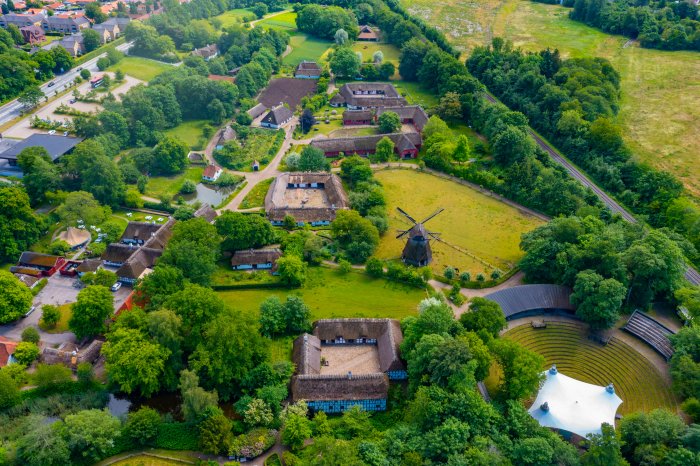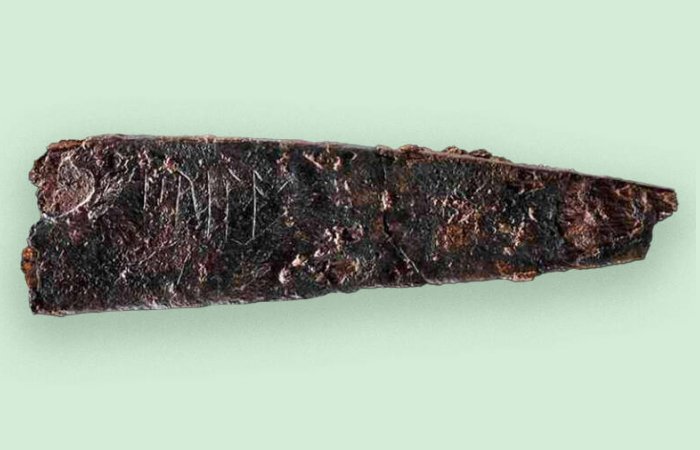Jan Bartek – AncientPages.com – When museum inspector and archaeologist Jakob Bonde dug up a 2,000-year-old knife with a runic inscription from a burial ground near Odense on the island of Funen, he did not know the find’s significance. Of course, Bonde was aware the ancient knife was valuable, but who would have thought that its runic inscription was 800 years older than the runes on the Jelling stones?

Aerial view of a field near Odense. Credit: Adobe Stock – dudlajzov
Runes played an essential part in the lives of the Vikings. As previously mentioned on Ancient Pages, “the word “rune” comes from Old Norse and means “Secret knowledge and wisdom.” Thousands of inscriptions in stone, wood, and metal have been unearthed, and each item gives us a glimpse into a culture that believed in the power and protection of the gods, telling fortunes and casting spells, and the glory of war.
The Vikings believed runes were created when their chief god Odin speared himself to the cosmic world tree, Yggdrasil, in hopes of receiving secret knowledge. The great Norse god Odin himself was regarded as the “Father of the Runes.”
According to Norse mythology, Odin speared himself to a tree so that he could receive the knowledge of the script. Suspended for nine windy nights, he learned their mysteries, which he pᴀssed on to his people.” 1
“In “Havamal” (or ‘Words of the High One’), which is one of the poems in the Codex Regius of the Elder Edda, it describes how to obtain the priceless runes, Odin voluntarily sacrificed himself on the Yggdrasil tree without bread and drink, until he died.” 2
Once Odin learned the secrets of the runes, he shared his knowledge with the other gods, and Heimdallr revealed much of these treasures to the people, but certainly not all of them.
Every runic discovery provides information about the lives of Norse people and Vikings.
The find on Funen was unexpected but of great importance.
“At first, we thought it was an ordinary iron knife, which is interesting in itself, but nothing unusual. It was only when one of our conservators was gently cleaning it that she really opened her eyes,” Bonde told the Danish Radio (DR).
Once the rust and dirt had been removed from the small knife blade, five engraved runes became visible, and it was obvious this was no ordinary iron knife.
The five runes are interpreted as the word ‘hirila‘, which in Old Norse can mean ‘Little Sword’.
Archaeologists are currently unable to determine whether ‘hirila’ is the name of the knife or the name of the knife’s owner. Still, the knife was undoubtedly extremely valuable to the people who buried it 2,000 years ago, explains Jakob Bonde, and it has not become less significant since.
“It is a unique experience to stand with such an old and finished written language. It is one of the most amazing things an archaeologist can experience because it is an incredibly rare find. With such a find in our hands, we come face to face with the past.

Archaeologists from Museum Odense have found Denmark’s oldest runic inscription, hirila, inscribed on a nearly 2,000-year-old knife blade. PH๏τo: Rógvi N. Johansen
Only once before have runes with the same dating as “Lille Sværd” been found. It was back in 1865 when, in Vimosen, west of Odense, a small bone comb with the inscription Sharjah was found.
It is spectacular that the oldest runes have been found within a few kilometers on Funen. Whether there is a connection, we cannot say anything about it yet, but it shows how rarely archaeologists make such finds,” Boden said.
Runologist Lisbeth Imer at the National Museum is impressed with the 2,000-year-old knife and its runic inscription. According to Imer, it is a highly unusual find that gives rare and important insight into the everyday life of our ancestors.
We rarely find runes that are as old as on this knife, and it is a unique opportunity to learn more about Denmark’s earliest written language and, thus, also about the language that was actually spoken in the Iron Age.
See also: More Archaeology News
A runic inscription is like finding a message from ancient people. Then, it is just before you can hear their voices. In addition, the discovery of the knife with the runes gives the museum a fantastic opportunity to connect the past with the present,” Imer said.
The old knife will be exhibited at Museum Odense, where it, together with other objects from the same excavation, will help to open a window to another time, says Jakob Bonde.
Written by Jan Bartek – AncientPages.com Staff Writer
Expand for references
- Ellen Lloyd – Runes: Facts And History About Odin’s Secret Language – AncientPages.com
- A. Sutherland – God Of The Gallows And How Odin Hanged Himself From Yggdrasil To Know Secrets Of Runes – AncientPages.com





